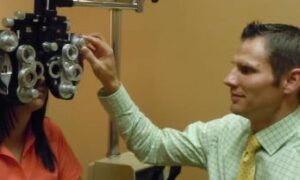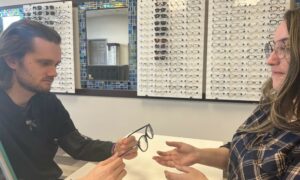By Brian Linde, OD
Enhance the lives of your patients by prescribing free-form spectacle lenses that meet lifestyle needs ranging from computer work to outdoor recreation. Loyalty and referrals will follow.
Our patients, like us, lead busy lives with many needs. Many are in the office for long hours where close-up work on the computer is required and most have both outdoor hobbies like golf that require peak distance vision and sun protection and indoor hobbies like handicrafts or home improvement, that require optimal close-up vision so no detail is missed. With those needs in mind, free-form lenses offer a way to enhance the lives of your patients. Here is how my practice makes the most of our use of Shamir free-form lenses.
Efficient Turnaround; Growing Profitability
We switched to Shamir progressive addition lenses about nine years ago. Our lab, Summit, is an optometrist-owned surfacing lab based in Helena, Mont., with about 80 OD partners. As the lab provides us a finished product, I don’t need to stock or inventory any Shamir lenses. There is no fancy equipment needed in my office to fit/dispense no-line multifocals. Shamir provided us with a Shamir Panorameter which is a handheld device that measures pantoscopic tilt, facial wrap (face form angle) and vertex distance. These measurements, along with monocular pupillary distance and center of pupil, are all the lab needs to surface and finish the Shamir freeform lenses.
Our free-form lens offering to patients started with the traditional Shamir line of lenses including Genesis, Piccolo and Office. The Creation, Autograph 2 and Autograph 2 Office are the freeform lenses. The older, traditional technology is still available and very good. But with the newer free-form lenses we have more options available in terms of designs and materials. Summit lab is able to deliver the finished eyeglasses to us in five to seven working days.
The newest freeform lenses retail for $70 to $80 dollars more than the older designs.
Educate Patients
We educate our patients regarding features and benefits. As free form is custom designed with specific measurements, patients can expect better optics. While the opticians take these measurements, they tell patients what they are measuring and how that impacts their ability to see clearly. For example, they might explain how a wider lens corridor, less aberrations and better peripheral vision provide better optics.
During the exam I inquire of my straight-top bifocal wearers if they have tried a no-line multifocal yet. Most have tried multifocals and failed to continue wearing them for one reason or another. Often the bifocal measurement was too small. With freeform we can fit as small as 11mm successfully. If the patient voices concerns about peripheral vision of corridor design I can explain the optics of free form. Our intake form asks lifestyle questions; as the doctor, I will ask additional ones. As I golf, fly fish and, at 51, struggle at the computer, I can share my experiences. For fly fishing, I use a polarized lens with an add power set for 10 inches. The Shamir Golf no-line lens allows me to see the golf ball without having to tip my head to my chest. The Office lens gives me a corridor that is three times wider than a traditional no line and a reading area twice as wide without having to tip my head back to see the computer.
Help for Work with Digital Devices
Most of your patients have digital devices like smartphones and tablets that can come with visual challenges. Free-form lenses often can improve patients’ use of these devices.
Shamir has a lens called In-Touch, which is designed for digital devices. It has a quicker add and is designed for the different angles and distances that we hold these hand-held devices. It has an intermediate zone that is 21 percent wider than traditional progressive lenses and a 22 percent wider reading area. As doctors and opticians, we need to understand these lens offerings in terms of how they can improve our patients’ functioning and enjoyment of everyday life, so we can fully explain the potential benefits.
Don’t Prejudge Patients’ Ability to Invest in Premium Lenses
Do not prejudge a patient’s ability to pay for better technology. Free-form lenses provide better optics and better vision. Recommend them! Patients come to us for our evaluation and insight. As optometrists we need to say “I recommend…” (recognize that this may be a multifunctional recommendation). Often we are not able to provide our patients everything they need in one pair of eyeglasses.
Ask the questions that will provide you with the information you need to improve your patients’ lives:
“Do you have to tip your head back to see the computer?”
“Are you experiencing any neck or back strain late in the day?” This question gives me the chance to talk about the Office lens.
“Do you have prescription sunglasses?” I can then talk about UV light and the high incidence of skin cancer, melanoma, cataracts, macula disease and dry eye. If the patient can verbalize a problem, they are receptive to my recommendations. If we ask these questions and make effective eyewear recommendations, then we have taken care of our patients and likely increased our revenue-per-patient.
Related ROB Articles
Removing Roadblocks to Change: Remembering Why Patients Come to “See” You
Be an Expert in Treating Computer Vision Syndrome
Ask Patients Detailed Lifestyle Questions…Then Select Best Lens Options
Brian Linde, OD, is a partner of Heights EyeCare in Billings, Mont. To contact him: BrLinde@Bresnan.net.

























